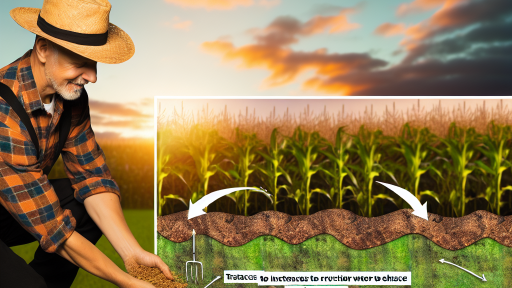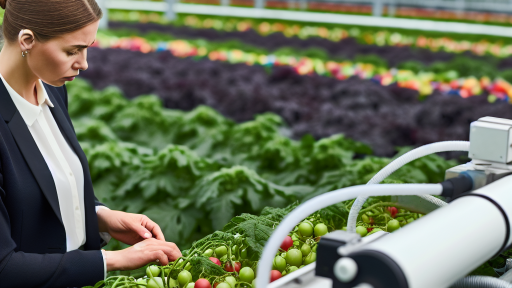Overview of Soil Testing
Importance of Soil Testing
Soil testing is crucial for successful farming.
It provides farmers with accurate information about soil health.
This information helps in making informed decisions about crops.
Moreover, testing reveals nutrient deficiencies and excesses.
Consequently, it guides the use of fertilizers effectively.
Farmers can enhance soil fertility through proper analysis.
Benefits for Farmers
Soil testing offers several key benefits to farmers.
First, it maximizes crop yields.
Farmers can optimize their inputs, ensuring better returns.
Additionally, it reduces wastage of resources and costs.
Soil tests help manage soil pH, improving nutrient availability.
This process ultimately leads to healthier crops.
Farmers also contribute to sustainable agricultural practices.
By understanding their soil, they minimize environmental impact.
Practical Applications of Soil Testing
Farmers can use soil tests in various ways.
Transform Your Agribusiness
Unlock your farm's potential with expert advice tailored to your needs. Get actionable steps that drive real results.
Get StartedThis includes determining the right type and amount of fertilizer.
Furthermore, soil tests assist in crop rotation planning.
They identify which crops will thrive in specific conditions.
Additionally, regular testing tracks soil health over time.
This ongoing assessment ensures long-term fertility and productivity.
Types of Soil Tests: A Comprehensive Guide
Overview of Soil Testing
Sole testing evaluates soil health and nutrient levels.
This process informs farmers about soil conditions.
It plays a vital role in sustainable farming practices.
Routine Soil Tests
Routine soil tests are essential for all farmers.
These tests measure pH levels and nutrient concentrations.
They help determine fertilizer needs for various crops.
Soil pH Test
The soil pH test measures acidity or alkalinity.
A pH of 6 to 7 is generally ideal for crops.
Farmers should adjust pH levels to improve crop yield.
Nutrient Analysis
This analysis evaluates essential nutrients like nitrogen and phosphorus.
It provides insights into nutrient deficiencies.
Farmers can then customize their fertilization strategies.
Specialized Soil Tests
Specialized tests address specific agricultural needs.
These can include tests for heavy metals or organic matter content.
Such tests guide remediation strategies for contaminated soils.
Micronutrient Testing
Micronutrient testing assesses trace minerals in soil.
Elements like zinc or iron are vital for plant health.
Farmers should monitor these levels regularly.
Contaminant Testing
Contaminant tests identify harmful substances in soil.
Showcase Your Farming Business
Publish your professional farming services profile on our blog for a one-time fee of $200 and reach a dedicated audience of farmers and agribusiness owners.
Publish Your ProfileThis is crucial for urban farming or industrial sites.
Farmers can take necessary actions to remediate affected areas.
Soil Texture Analysis
Soil texture analysis examines the soil’s composition.
It determines the percentage of sand, silt, and clay.
Understanding texture helps in irrigation and crop selection.
Texture Methods
Farmers can conduct texture tests using various methods.
These include the feel method or sedimentation tests.
Both methods provide valuable information about soil behavior.
Benefits of Soil Testing
Soil testing offers numerous advantages for farmers.
Firstly, it increases crop productivity and efficiency.
Secondly, it helps conserve resources and reduces waste.
Cost Efficiency
By understanding nutrient needs, farmers can save money.
Targeted fertilization reduces costs associated with excess application.
Thus, soil testing leads to more sustainable practices.
Environmental Impact
Proper soil management reduces environmental degradation.
Testing minimizes runoff and promotes soil health.
This ultimately benefits the surrounding ecosystems.
How to Collect Soil Samples: Best Practices and Methodologies
Understanding Soil Sampling
Sole sampling is crucial for effective soil testing.
It provides insights into soil nutrient levels and health.
Moreover, proper sampling techniques lead to accurate results.
Selecting Sampling Locations
Identify areas that represent your field accurately.
Consider variances such as soil type and crop history.
Avoid areas with obvious chemical or physical differences.
Tools for Soil Sampling
Use a clean soil probe or auger for sampling.
Make sure your tools are free from contaminants.
Consider a trowel or spade for smaller sample collections.
Sampling Depth and Frequency
Collect samples from the top six inches for most crops.
Adjust depth based on the specific crop needs.
Sample at various depths if deeper rooting crops are grown.
Regular sampling every few years ensures up-to-date data.
Collecting Soil Samples
Gather multiple subsamples from different locations.
Mix these subsamples thoroughly in a clean container.
Remove any debris such as rocks or plant matter.
Ensure the sample is representative of the entire area.
Proper Sample Handling
Label each sample clearly with date and location.
Store samples in moisture-proof bags or containers.
Avoid exposing samples to direct sunlight or high temperatures.
Sending Samples for Testing
Contact your lab to understand required protocols.
Complete a submission form describing your samples.
Follow all shipping guidelines to ensure sample integrity.
Showcase Your Farming Business
Publish your professional farming services profile on our blog for a one-time fee of $200 and reach a dedicated audience of farmers and agribusiness owners.
Publish Your ProfileTrack your samples to confirm receipt at the lab.
See Related Content: Integrated Pest Management in Aquaponics
Interpreting Soil Test Results: What Farmers Need to Know
Understanding Soil Test Values
Soyl test results provide critical information about soil health.
Farmers can better manage their land with this information.
Understanding key values is essential for effective interpretation.
Key Parameters in Soil Tests
Common parameters include pH, nutrients, and organic matter.
Soil pH indicates acidity or alkalinity levels in the soil.
Nutrients such as nitrogen, phosphorus, and potassium are vital.
Organic matter contributes to soil structure and nutrient retention.
Interpreting pH Levels
Soil pH affects nutrient availability to plants.
Most crops thrive in a pH range of 6.0 to 7.5.
Adjustments may be necessary if pH falls outside this range.
Lime can raise pH, while sulfur can lower it.
Understanding Nutrient Levels
Nitrogen is crucial for plant growth and leaf development.
Phosphorus supports root and flower development.
Potassium enhances drought resistance and overall plant health.
Farmers should aim for balanced nutrient levels.
Recognizing Organic Matter Importance
Organic matter enhances soil fertility and structure.
It improves water retention and microbial activity.
Farmers should strive for at least 5% organic matter in their soil.
Utilizing Soil Test Recommendations
Soil tests often come with recommendations for amendments.
Following these recommendations can optimize crop production.
Farmers should consider soil tests as a roadmap for fertility management.
Regular testing helps track changes and adjust practices accordingly.
Gain More Insights: Soil Microbiology: Enhancing Fertility Naturally
Frequency of Soil Testing: How Often Should It Be Done?
The Importance of Regular Soil Testing
Regular soil testing is essential for effective farm management.
It helps farmers understand nutrient levels in their soil.
Moreover, testing reveals pH levels that affect crop growth.
Consistency in testing can lead to better farming decisions.
Factors Influencing Testing Frequency
The type of crops grown significantly impacts testing frequency.
For instance, heavy feeders require more frequent testing.
Also, soil properties such as texture and drainage play a role.
Additionally, climatic conditions influence nutrient leaching.
Farmers should consider these factors when planning tests.
Recommended Testing Schedule
- For annual crops, conduct soil tests every year.
- For perennial crops, testing every three years is sufficient.
- In high-input systems, consider testing before each planting season.
- Testing after applying fertilizers helps in assessing changes.
Adjusting Frequency Based on Results
Pay attention to previous test results.
If nutrient levels remain stable, testing can be less frequent.
Conversely, significant variation warrants more frequent checks.
Thus, adapting to soil conditions ensures optimal fertility management.
The Role of Soil Amendments
Applying soil amendments can change nutrient levels over time.
Therefore, retesting after amendments is crucial.
Showcase Your Farming Business
Publish your professional farming services profile on our blog for a one-time fee of $200 and reach a dedicated audience of farmers and agribusiness owners.
Publish Your ProfileThis practice helps in understanding the effectiveness of inputs.
It also aids in tailoring future amendments based on needs.
Best Practices for Effective Soil Testing
Farmers should aim for a proactive soil testing schedule.
Integrating testing into their annual plans promotes sustainability.
Ultimately, regular analysis leads to improved crop yields.
Delve into the Subject: Optimizing Light for Hydroponic Growth

Common Soil Amendments Based on Test Results
Understanding Soil Test Results
Ssoil testing provides vital information about nutrient levels in your soil.
These results help farmers decide which amendments to apply.
Common metrics from soil tests include pH, nitrogen, phosphorus, and potassium levels.
Understanding these metrics guides effective soil management strategies.
Choosing the Right Amendments
Different soil issues require specific amendments for improvement.
A low pH indicates acidity, which can be adjusted using lime.
For nutrient deficiencies, organic matter like compost enhances soil health.
In cases of high phosphorus, consider using a slow-release fertilizer.
Adjusting for Specific Nutrient Needs
Nitrogen deficits often occur in sandy soils.
Applying urea or ammonium sulfate can effectively address this issue.
Phosphorus can be supplemented with bone meal or rock phosphate.
Potassium deficiencies may require the application of potassium chloride or sulfate.
Improving Soil Structure
Soil amendments can also enhance soil structure and drainage.
Adding gypsum can help improve the structure of clay soils.
Organic amendments, such as well-rotted manure, improve soil aeration.
Integrating cover crops fosters organic matter and protects against erosion.
Sustainability Considerations
Choose organic amendments to support sustainable farming practices.
These amendments reduce chemical runoff and promote healthy ecosystems.
Consider the long-term impacts of each amendment on soil health.
Regular testing ensures that your soil remains productive and balanced.
Application Tips
Apply amendments based on the specific needs revealed by your soil test.
For best results, integrate amendments into the top layers of soil.
Consider conducting follow-up tests after applying amendments.
This practice helps monitor the effectiveness of your soil management efforts.
Delve into the Subject: Scaling Up Your Aquaponics Business
Tools and Equipment for Effective Soil Testing
Essential Tools for Soil Sampling
Farmers need reliable tools for soil sampling.
A soil auger serves as a primary tool for this purpose.
It allows users to collect soil from various depths efficiently.
A trowel is useful for smaller gardens or test areas.
Sampling bags help preserve samples for analysis.
Measuring Soil pH
Understanding soil pH is crucial for crop health.
A good quality pH meter provides accurate results.
Farmers can also use pH test kits as an alternative.
These kits often include color-coded charts for easy reading.
Showcase Your Farming Business
Publish your professional farming services profile on our blog for a one-time fee of $200 and reach a dedicated audience of farmers and agribusiness owners.
Publish Your ProfileRegular pH testing helps maintain optimal soil conditions.
Assessing Nutrient Levels
Soil test kits can assess nutrient levels.
These kits typically analyze nitrogen, phosphorus, and potassium.
Farmers can choose kits based on their specific needs.
Some advanced kits even measure micronutrient levels.
Understanding nutrient levels helps optimize fertilization strategies.
Laboratory Testing Services
For comprehensive analysis, farmers should consider lab services.
Local agricultural extension offices often offer these services.
Sending samples to a lab provides detailed reports on soil health.
Lab analyses can also recommend specific amendments and treatments.
Utilizing lab resources ensures informed decision-making in farming practices.
Best Practices for Soil Testing
Proper timing enhances the effectiveness of soil tests.
Testing should occur at least every three years.
Conduct tests before planting to make necessary amendments.
Sampling at various locations within a field provides better insights.
Additionally, follow the instructions for each testing kit carefully.
Case Studies: Successful Soil Testing and Its Impact on Crop Yields
Improving Yields with Soil Analysis
Farmers have significantly increased their crop yields through effective soil testing.
One notable case involves the Thompson family farm in Nebraska.
They employed comprehensive soil analysis to identify nutrient deficiencies.
As a result, they improved their fertilizer application strategy.
This adjustment led to a 30% increase in corn production.
Long-Term Soil Health Management
Moreover, soil testing enhances long-term soil health management practices.
The Garcia farm in California illustrates this benefit clearly.
They regularly tested their soil to monitor organic matter levels.
By implementing cover cropping based on test results, they boosted soil fertility.
This led to thriving fruit and vegetable yields year after year.
Regional Focus: The Midwest
In the Midwest, soil testing has proved particularly beneficial for soybean farmers.
The Johnson family, in Ohio, adapted their practices after routine testing.
They discovered high phosphorus levels impacting soy yield negatively.
Adjusting their nutrient management plan resulted in healthier, higher-yielding crops.
Consequently, their revenue increased substantially over the past season.
Integrating Technology in Soil Testing
Technology integration has transformed soil testing techniques as well.
The Roberts agricultural company utilizes advanced drone technology to assess soil conditions.
This method allows them to collect data from large areas efficiently.
The insights gained lead to more precise interventions for nutrient management.
As a result, their crop yields have risen consistently over five years.
Community Benefits of Soil Testing
Soy testing also fosters community-driven agricultural improvements.
The Evergreen Cooperative in North Dakota stands out in this area.
They organize local soil testing sessions for neighboring farms.
Sharing results allows farmers to formulate collective strategies for crop management.
Showcase Your Farming Business
Publish your professional farming services profile on our blog for a one-time fee of $200 and reach a dedicated audience of farmers and agribusiness owners.
Publish Your ProfileThis communal approach has enhanced overall food security in the region.
Additional Resources
Precision Agriculture: Benefits and Challenges for Technology …




